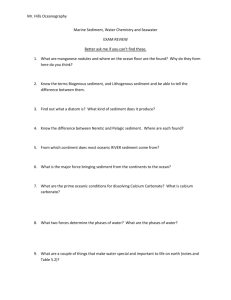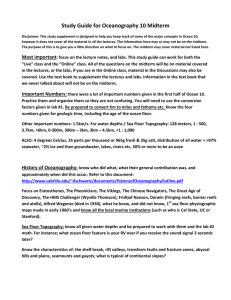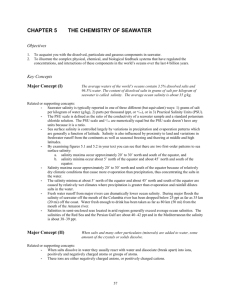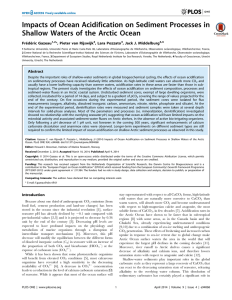Oceanography review questions
advertisement
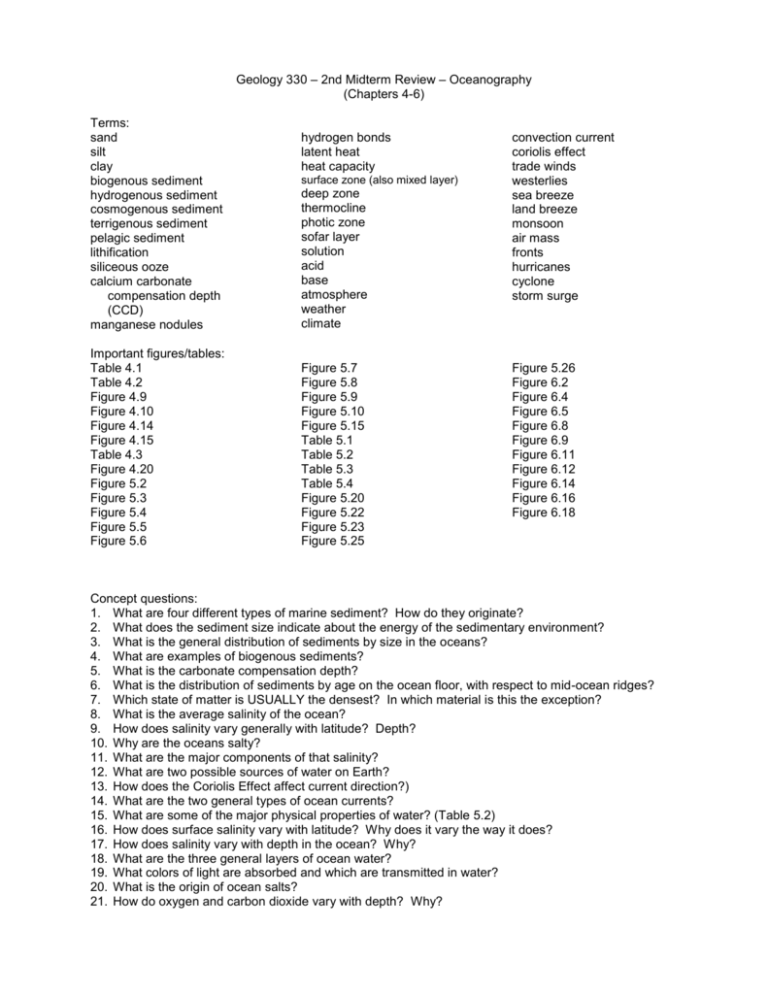
Geology 330 – 2nd Midterm Review – Oceanography (Chapters 4-6) Terms: sand silt clay biogenous sediment hydrogenous sediment cosmogenous sediment terrigenous sediment pelagic sediment lithification siliceous ooze calcium carbonate compensation depth (CCD) manganese nodules Important figures/tables: Table 4.1 Table 4.2 Figure 4.9 Figure 4.10 Figure 4.14 Figure 4.15 Table 4.3 Figure 4.20 Figure 5.2 Figure 5.3 Figure 5.4 Figure 5.5 Figure 5.6 hydrogen bonds latent heat heat capacity surface zone (also mixed layer) deep zone thermocline photic zone sofar layer solution acid base atmosphere weather climate Figure 5.7 Figure 5.8 Figure 5.9 Figure 5.10 Figure 5.15 Table 5.1 Table 5.2 Table 5.3 Table 5.4 Figure 5.20 Figure 5.22 Figure 5.23 Figure 5.25 convection current coriolis effect trade winds westerlies sea breeze land breeze monsoon air mass fronts hurricanes cyclone storm surge Figure 5.26 Figure 6.2 Figure 6.4 Figure 6.5 Figure 6.8 Figure 6.9 Figure 6.11 Figure 6.12 Figure 6.14 Figure 6.16 Figure 6.18 Concept questions: 1. What are four different types of marine sediment? How do they originate? 2. What does the sediment size indicate about the energy of the sedimentary environment? 3. What is the general distribution of sediments by size in the oceans? 4. What are examples of biogenous sediments? 5. What is the carbonate compensation depth? 6. What is the distribution of sediments by age on the ocean floor, with respect to mid-ocean ridges? 7. Which state of matter is USUALLY the densest? In which material is this the exception? 8. What is the average salinity of the ocean? 9. How does salinity vary generally with latitude? Depth? 10. Why are the oceans salty? 11. What are the major components of that salinity? 12. What are two possible sources of water on Earth? 13. How does the Coriolis Effect affect current direction?) 14. What are the two general types of ocean currents? 15. What are some of the major physical properties of water? (Table 5.2) 16. How does surface salinity vary with latitude? Why does it vary the way it does? 17. How does salinity vary with depth in the ocean? Why? 18. What are the three general layers of ocean water? 19. What colors of light are absorbed and which are transmitted in water? 20. What is the origin of ocean salts? 21. How do oxygen and carbon dioxide vary with depth? Why? 22. 23. 24. 25. 26. 27. 28. 29. 30. What is the pH of seawater? What are the relative concentrations of major salt components in seawater? How can seawater’s density be altered? Where can masses of seawater be observed to be sinking? Why? What is the difference between climate and weather? What is the composition of dry atmosphere? How much water vapor can be in Earth’s atmosphere? What role does CO2 play in the Greenhouse effect? How does the angle at which the Sun’s rays change with latitude? How does this affect temperatures at those latitudes? 31. What causes the seasons? 32. At which latitudes would you find the Tropic of Cancer? Tropic of Capricorn? Arctic Circle? Antarctic Circle? 33. At which latitudes do the sun’s rays strike the Earth perpendicularly at the solstices? The equinoxes? 34. What is the relative difference between the length of day and night for each of the seasons in each hemisphere? 35. What is Earth’s albedo? What is an example of a high albedo surface? a low albedo surface? 36. What are the two basic scales for measuring temperature? How do they differ? 37. Why do oceans (or rather large bodies of water) tend to have a moderating effect on coastal areas? 38. What types of seasonal temperature differences generally exist for areas farther from oceans? 39. Relatively speaking, what is the difference in the amount of heat required to raise the temperature of H20 compared to the amount of heat required to change H20 from one state of matter to another? 40. With respect to water vapor, what does saturation mean? 41. What does rising air in the atmosphere tend to do? 42. How do air masses move at Earth's surface around high & low pressure centers? In which direction do they circulate? 43. How do air masses move vertically above low and high pressure centers? 44. What causes the Coriolis Effect? How does it affect the way air circulates around high & low pressure centers? 45. What are trade winds? How do they blow? 46. What kind of wind patterns develop in a rotating Earth? 47. How do hurricanes form? Where do most hurricanes form? 48. What are some other names for hurricanes used in other parts of the world? 49. What kind of barometric pressure is at the center of a hurricane? 50. Under what conditions does a hurricane build or maintain its strength? 51. Under what conditions does a hurricane weaken? 52. What time of the year is hurricane season? 53. What are three categories of damage caused by hurricanes? 54. What is the El Niño/Southern Oscillation? 55. What is the Greenhouse effect? Which gases produce the strongest Greenhouse effect?
